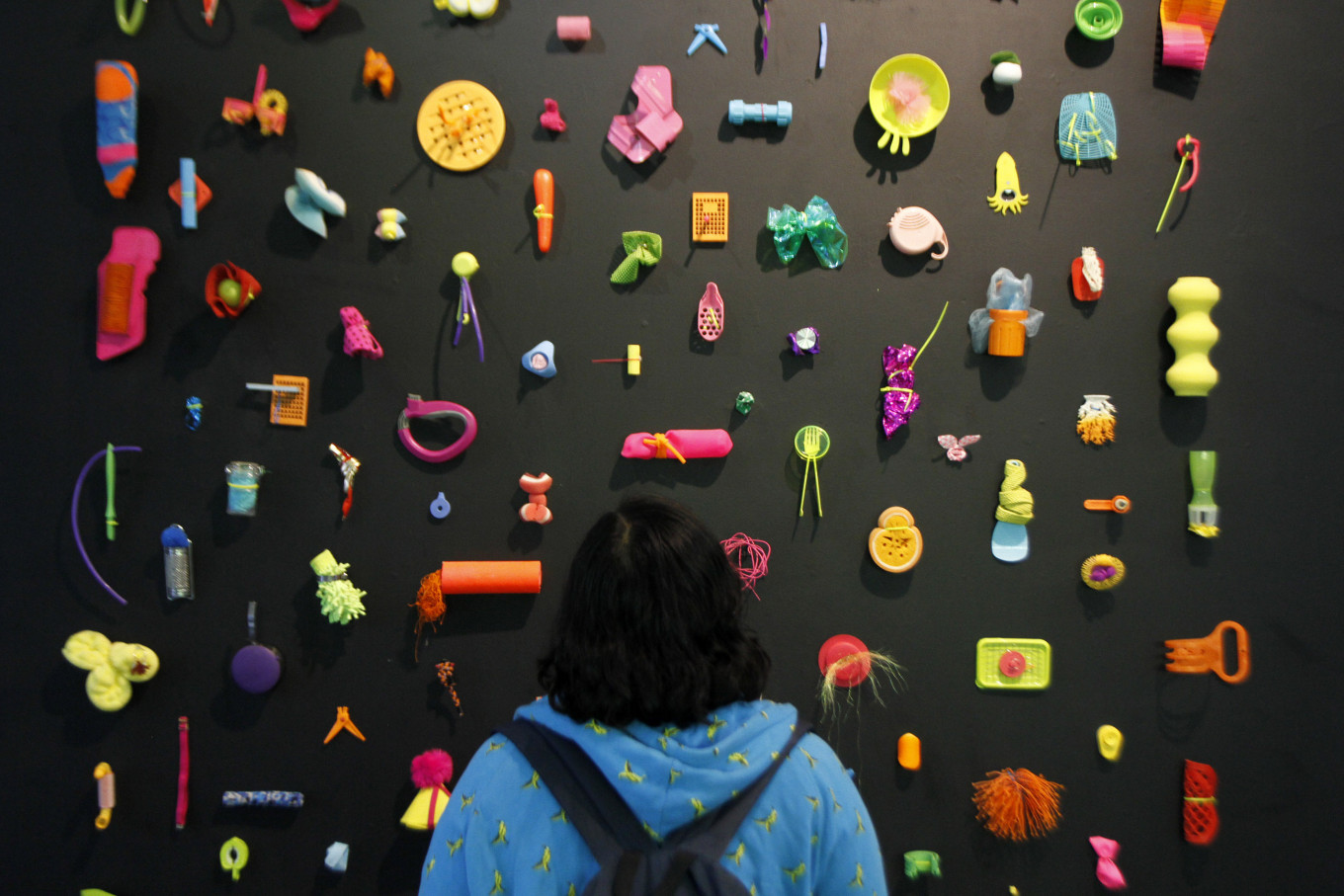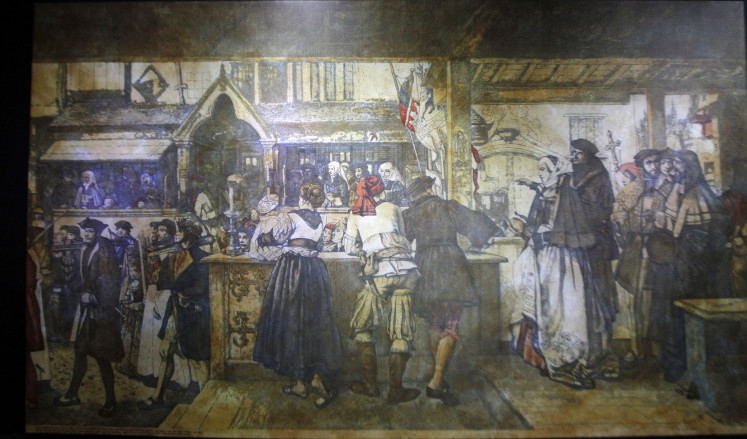Popular Reads
Top Results
Can't find what you're looking for?
View all search resultsPopular Reads
Top Results
Can't find what you're looking for?
View all search resultsBaCAA: An assembly of Indonesia’s finest contemporary artists
BaCAA is an art appreciation program aimed at stimulating contemporary art development in Indonesia.
Change text size
Gift Premium Articles
to Anyone
In Bandung, West Java, 26 of Indonesia’s finest artists gathered to ignite more public interest in contemporary art.
Artist Aliansyah “Alin” Caniago remembers fondly the day he won the Bandung Contemporary Art Award (BaCAA) in 2015 with a physically demanding performance piece.
Alin hauled a boat along a 22-kilometer road that connected Bandung and Cianjur, also in West Java. With a rope fastened to his shoulders, he dragged the boat from Situ Ciburuy Lake in Padalarang to Bandung city.
This performance took nine hours to complete and was titled Point of Return Project: Situ Ciburuy.
Alin considered the performance, which earned him an award at the fourth BaCAA, as the peak of his artistic career.
“I finally earned the public recognition and self-confidence to appear in the world of art. I received legitimacy [as an artist],” Alin said.
Since then, he has received numerous invitations to participate in art shows at home and abroad.
BaCAA is an art appreciation program aimed at stimulating contemporary art development in Indonesia.
Since BaCAA’s establishment in 2010, organizer Artsociates has launched competitions without implementing restrictions on media and themes, setting only an age limit of between 20 and 40 years old for participants. Three best artists are offered a residency and art trips to global contemporary art centers, as well as Rp 100 million (US$7,011) in prize money.
“Ide Menjaga Reputasi” (Ideas To Keep Reputation) by Eddy Susanto. (JP/Arya Dipa)The lack of restrictions was what attracted Anggun Priambodo, who was one of the three winners in the first BaCAA, to take part.
“With BaCAA, there are additional exhibition portfolios and new experiences. There are video contests rather than just ordinary displays,” said Anggun, who graduated from the Jakarta Arts Institute (IKJ).
In the first BaCAA, Anggun entered a piece called Sinema Elektronika (Electronic Cinema), a four-minute parody of Indonesian soap operas. He included various visual and audio elements depicting urban life in Indonesia to show how such television dramas, a popular form of public entertainment, sold consumerism and excessive violence.
To mark the decade-long mission of BaCAA, Artsociates gathered 26 former participants in an exhibition titled BaCAA ASSEMBLAGE: A Recollection of BaCAA Finalists From 2010 to 2017 at the Lawangwangi Creative Space in Bandung.
Open to the public from Feb. 22 to March 22, ASSEMBLAGE embraces diverse themes that appeal to those familiar with the works of BaCAA artists.
One of the former finalists is Deni Ramdani, who created for the fifth BaCAA an installation called 0°, featuring a plastic bag filled with water and live fish that was dropped onto a pile of dirt taken from north Bandung.
For ASSEMBLAGE, Deni featured a piece called Enclave, which uses galvanized iron sheets from north Bandung to partition space. He seems to have revisited the issue of water absorption in north Bandung, but it is more directly executed than before.
Another former BaCAA finalists, Harits Rasyid Paramasatya, initiated a discourse that may accurately describe current conditions in society.
A contemplation: A visitor observes “Sensor” (Censor) from Harits Rasyid Paramasatya. (JP/Arya Dipa)He brings his work called Sensor (Censor) in the form of wooden drawers containing plates that bear words in black lettering. The 26-year-old utilizes history book clippings that are enlarged and kept in the glass-covered drawers.
For Harits, information transparency is just an illusion as the authorities often benefit from history and information to preserve their power, unabashedly changing history despite the presence of other records for comparison.
Diverse themes and media constitute the strength of BaCAA displays, serving also as an arena of competitions.
Rizki Ahmad Zaelani, a curator of the Indonesian National Gallery and concurrently also this exhibition, said the works of BaCAA graduates were comparable to those of contemporary platforms around the world.
“In this way, BaCAA participants’ works encourage the emergence of referential creations, otherwise they can’t be globally competitive. The works chosen by jurors tend to embody conceptual art creations,” Rizki said.
Meanwhile, Artsociates director Andonowati, who is also the initiator and organizer of BaCAA, hoped the competitions would be relevant to the future growth of fine arts.
Like in previous events, the committee fully entrusts the task of evaluating the works to a jury panel of fine art stakeholders, comprising collector Wiyu Wahono, curator Asmudjo Jono Irianto, artist Melati Suryodharmo, Singapore-based collector Hady Ang, writer Naima Moreli and Pei-Yu Lin of Project Fulfill.
For Andonowati, artists are like a start-up company whose fundamentals should first be built in such a way that someday they are ready to go public. The go-public concept she means refers to the time when artists’ works gain access to auction centers.
“With good fundamentals, the works should be owned by collectors and appreciated by institutions through different exhibitions as well as by curators. Such fundamentals require serious efforts for years,” she said.
Curator Asmudjo regarded the diverse themes and media as a challenge to the jury due to the lack of parameters for evaluating the works.
“The practice of art in the market context has to do with an artist’s career, which is opened by opportunities. In Indonesia, [contemporary] artists have no easy job as public education in conceptual and experimental works is almost absent, except via biennales,” Asmudjo said.
Exhibitions like ASSEMBLAGE can serve as a bridge for the public to recognize, understand and collect contemporary artworks.
“The contemporary art market is very small. Collectors will surely seek fluid objects [like paintings]. This event should trigger public love for or comprehension of contemporary fine arts,” Asmudjo said. (hdt)













